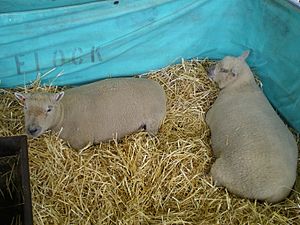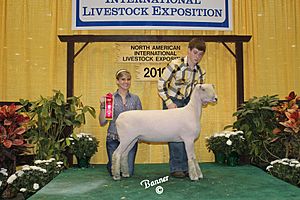Southdown sheep facts for kids

The Southdown is a small, gentle sheep from England. It's mostly raised for its meat. This breed was first developed by John Ellman in East Sussex about 200 years ago. Later, Jonas Webb helped make them a bit larger. Southdowns were even sent to New Zealand and helped create the famous Canterbury lamb.
It's important not to confuse the regular Southdown with the Olde English 'Babydoll' Southdown sheep. They are related but have some differences!
Southdown sheep were also used to create other sheep breeds, like:
- The Hampshire, by mixing with the Wiltshire Horn and Berkshire Nott.
- The Oxford Down, through the Hampshire and Cotswold sheep.
- The Suffolk, by mixing with the Norfolk Horn.
In Britain, the Southdown is seen as a native breed. It's now popular with smaller sheep farmers.
Contents
What Makes Southdown Sheep Special?
Southdown sheep have changed a bit over time. Today, the Southdown sheep raised for meat are usually bigger than the "traditional" ones from long ago. Southdowns in North America are also taller than those in England.
The original English Southdown sheep are now known as the Olde English 'Babydoll' Southdown sheep in the US. These "Babydoll" sheep are kept smaller, focusing more on their wool and as pets or for hobbies, rather than for meat.
In places like California and New Zealand, these smaller "Babydoll" sheep are sometimes used in vineyards. They eat weeds without reaching the grapes on the vines because they are too short! Many "Babydoll" breeders believe their sheep are more like the original English Southdowns.
Adult male Southdown sheep (rams) usually weigh between 190 to 230 pounds (86-104 kg). Females (ewes) weigh from 130 to 180 pounds (59-81 kg). Their wool is medium-thick and soft. It's about 1.5 to 2.5 inches (4-6 cm) long.
History of the Southdown Sheep
Sheep have been in Sussex, England, for a very long time. Around 1341, there were about 110,000 sheep there. Their wool was known for being very fine and good quality.
In 1780, John Ellman saw how special these sheep were. He worked to make the Southdown breed even better and more consistent. For many years, especially in the 1800s, you could find huge numbers of Southdown sheep in the South Downs area near Lewes.
In 1813, a farmer named Arthur Young thought there were 200,000 ewes on the eastern South Downs. He said it was amazing how many sheep they kept in England.
These sheep were very important for keeping the farm land healthy. The South Downs have chalky soil, which isn't naturally rich. The large flocks of sheep would graze on the open hills during the day. At night, they were moved to lower farm fields. Their droppings helped make the soil fertile. This meant farmers could grow crops like wheat more easily the next year. This farming method became very popular, especially from 1845 to 1880.
In the 1900s, people started keeping official records of purebred Southdown sheep. By 1911, there were over 114,000 breeding ewes in Britain across 359 registered farms.
However, things changed during the First World War. Many shepherds and farm workers went off to fight, and the number of Southdown flocks quickly dropped. By 1922, there were only 245 registered flocks left.
New farming methods also appeared, like using artificial fertilizers. This meant farmers didn't need sheep to fertilize their fields as much. Southdown sheep then became more of a grassland breed. Even so, during the years between the two World Wars, many purebred Southdowns were sent to other parts of the world, especially New Zealand. In 1937, 459 Southdowns were exported.
During the Second World War, some of the South Downs land was used for military training. Sheep farming continued to decline after the war. But now, efforts are being made to encourage sheep farming again in these areas. The Southdown is now on a "watch list" by the Rare Breeds Survival Trust. This means they are being carefully watched to make sure their numbers don't get too low.
Southdown Sheep in the United States
The first Southdown sheep likely arrived in the United States in 1803. They became popular because they were easy to care for and didn't have as many problems as some other sheep breeds.
However, their popularity later declined, similar to what happened in England. Also, people wanted larger cuts of meat, and the original Southdowns were too small for this demand. This led to the development of a larger, taller Southdown sheep in the US. This was the start of two different types of Southdown sheep in America.
The American Southdowns were bred to be larger. This was done by mixing the original Southdown bloodlines with bigger Southdown sheep from other countries. The goal was to create a sheep that could compete with other large meat breeds in the US. But, some of the original good qualities of the Southdown were lost in this process.
In 1986, a breeder named Robert Mock started looking for sheep that still had the original Southdown features. After searching for four years, he found two small groups of sheep, totaling 26 animals. But this wasn't enough to create a healthy new group. Mock kept searching, and by 1990, he found 350 Southdown sheep that had the original bloodlines. Many of them even had their original registration papers from the UK.
At that time, Mock started the first Olde English Southdown Registry. He wanted to market this sheep breed for a new purpose: as pets and for 4H projects (which are like clubs for young people interested in agriculture). He also started using the name "Babydoll" for these sheep.
When Mock and his team were finding sheep for the new registry, they only accepted adult "Babydoll" sheep (two years or older). This was so they could be sure the sheep met the original standards. A veterinarian checked each sheep. A group of three people from the new registry had to approve each sheep's registration. This "Foundation Flock" registry closed in 1991. After that, they started registering lambs born from this new group of sheep.
Images for kids
-
Southdown ram, from the Encyclopædia Britannica, 1911



